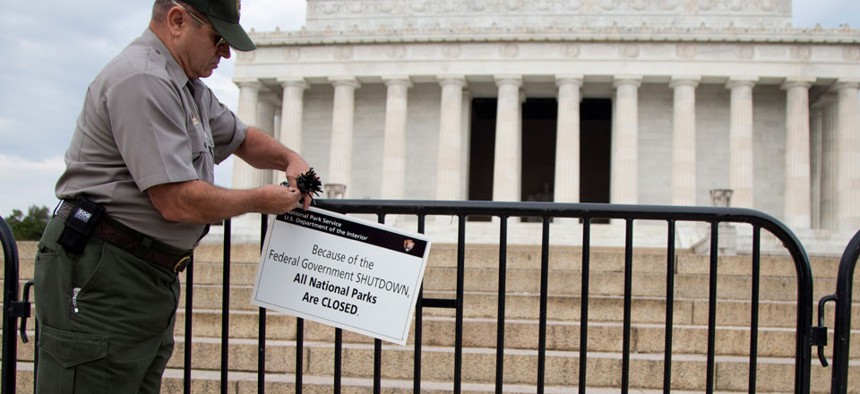
Carolyn Kaster/AP
OMB Puts Shutdown’s Federal Payroll Cost at $2.5 Billion
Feds took a total of 6.6 million furlough days; lost productivity not tabulated.
The cost of shuttering the government during 16 days in October was at least $2 billion in retroactive payments to furloughed workers, for a total of $2.5 billion counting benefits, the Office of Management and Budget announced on Thursday. Combined, federal employees took a cumulative total of 6.6 million furlough days during the shutdown.
The report on the “economic, budgetary and programmatic costs” of the October 2013 government shutdown differs from a report released after the fiscal 1996 shutdown -- which put the total shutdown cost at $2.1 billion in today’s dollars -- in that it makes no attempt at an overall cost figure.
Instead, OMB Director Sylvia Mathews Burwell explained in a conference call with reporters, the 2013 report lays out indirect and some agency-specific costs. But it asserts that the recent shutdown was more costly than the two-part partial closure for 25 days during the Clinton administration because it affected all agencies, given that no fiscal 2014 appropriations bills had been signed into law when the funding lapse began.
“As the president has said, the shutdown that occurred last month inflicted completely unnecessary damage on our economy and took a toll on families and businesses across the country,” Burwell said, noting the report’s specific focus on the impact on the federal workforce. “The shutdown and sequestration-related furloughs risk undermining the competitive advantage agencies have traditionally used in recruiting a talented workforce -- income stability provided by civil service jobs, and a calling to the important work of public service,” the report said.
OMB noted that private sector analysts estimate that the shutdown will reduce fourth-quarter Gross Domestic Product growth by 0.2-0.6 percentage points, or $2 billion-$6 billion in lost output, and that the Council of Economic Advisers estimates the recent brinksmanship over the budget and the debt ceiling may have resulted in 120,000 fewer private-sector jobs created during the first two weeks of October.
The personnel cost of the shutdown is “a conservative number because it does not cover all the preparation leading up to and what happened post-shutdown,” Burwell said.
The report ranks the agencies by number of furlough days employees took, with Defense highest (at 1.6 million furlough days), followed by Treasury (at 985,000 furlough days) and Agriculture (at 737,000 furlough days).
Unclear, Burwell said, is the amount the government will be required to pay in interest, which will be done by individual agencies on a “contract by contract basis.”
The report offers a litany of services denied to citizens and specific harm to agencies providing such services, along with examples of frozen federal activity that dampens economic movement and several examples of forgone federal revenue. Among them:
- The Bureau of Land Management was unable to process about 200 applications for drilling permits;
- The Bureau of Alcohol, Tobacco, Firearms and Explosives couldn’t issue permit export certificates for 2 million liters of beer, wine and spirits;
- The Internal Revenue Service couldn’t process 1.2 million mortgage verification requests, delayed almost $4 billion in tax refunds and announced plans to delay the start of the 2014 tax filing season by up to two weeks;
- The Small Business Administration was unable to process about 700 applications for $140 million in small business loans;
- The National Park Service lost $7 million in fee revenue, and the Smithsonian Institution lost $4 million.
Examples of lost productivity included the Federal Housing Administration, which was unable to process more than 500 applications for loans to develop, rehabilitate, or refinance some 80,000 multifamily rental units, and the largely staff-less National Science Foundation, which ordinarily processes 765 grants in a two-week period, but was mostly shut down.
Burwell agreed that the overall cost would be well “in excess of $2 billion. One piece of philosophy is that we have tried to be as transparent as possible and as correct analytically as possible,” she said. Asked whether the report is intended to influence the current budget talks or to open the public’s eyes to the costs of a shutdown, Burwell said, “There was negative impact on our economy, directly and indirectly, negative impact on what we are all trying to do in running the government more efficiently, and negative impact because of programmatic things that affect daily lives, both economic and personal.”
One thing that did come out of the crisis among the public, Burwell added is “a greater appreciation for a number of things government did.”
OMB executed the report, she said, because it had received a number of requests, including one from Sen. Barbara Mikulski, D-Md., chairwoman of the Senate Appropriations Committee.
The Government Accountability Office, as of Wednesday, was still considering a request by Sen. Mark Warner, D-Va., for its own study on the shutdown’s cost.
“I hope all lawmakers keep a copy of OMB’s report by their side as they engage in other budget debates,” said American Federation of Government Employees National President J. David Cox Sr. in a statement. “They all need to remember that putting vital government services at risk to score political points is a costly exercise that has ruinous consequences for our government and the country.”







